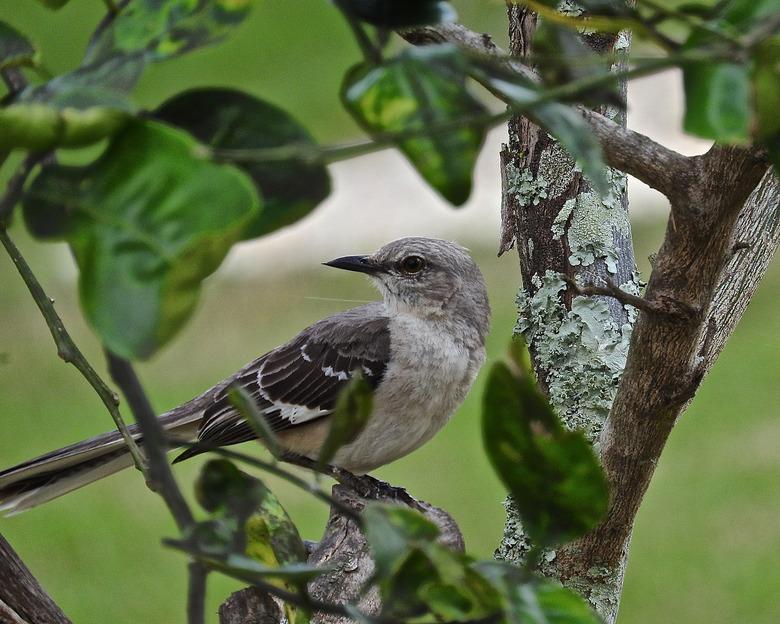How To Tell A Male From A Female Mocking Bird
The northern mockingbird (Mimus polyglottos) is found throughout the continental United States, Canada and Mexico. Mockingbirds belong to a family of New World mimic thrushes, or mimids, and are by far the most skilled mimics in the family. Their vocalizations can copy other songbirds, dogs barking and even machinery. Some mockingbirds learn as many as 200 songs as part of their vocal repertoire. While mockingbird males and females bear a strong resemblance to each other, they can be distinguished in a number of ways.
TL;DR (Too Long; Didn't Read)
Male and female mockingbirds look quite similar. They can be distinguished by the slightly larger size of the male, the more prolific singing and mimicry by males, breeding behavior, nest construction, fledgling training and by territorial defense. Females alone incubate their nests.
Mockingbird Attributes
Mockingbird Attributes
Northern mockingbirds are medium-sized, gray-backed slim birds with pale breasts and light bellies. Their black beaks curve down. Their tails and rounded wings bear obvious white patches. These white marks provided striking displays in the birds' flight and mating rituals. Males average slightly larger than females, from between 22 to 25.5 centimeters long and 51 grams in weight. Females, while similarly plumed, average between 20.8 to 23.5 centimeters in length and approximately 47 grams in weight.
Vocalization Differences
Vocalization Differences
The male and female mockingbirds both sing. The males, however, boast a far greater range of vocalization and frequency of song. Males mimic the songs of other birds, frogs, dogs, sirens and even alarm clocks. They sing different sets of songs, one for spring and one for autumn. The males increase their singing for spring breeding season. Their impressive vocal roster serves the purpose of attracting a female for breeding, and also for defending their territory. Females prefer males with a more varied set of songs, which signals experience and an established territory. Unmated males burst into song at all hours seeking a mate, even at night, much to the dismay of their human neighbors. Such nocturnal singing in a traditionally diurnal bird puts these particular males at risk of predation. Females, in contrast, do not sing often during breeding season. Females do sing in autumn. Scientists think the males' singing resets the female's reproductive system.
Breeding Behaviors
Breeding Behaviors
A male must establish a territory in order to attract a female. One reason mockingbirds are found in cities is the abundance of ornamental trees and fruits, which provide excellent territories for males. Male mockingbirds court females with songs, by chasing, showing them potential nesting areas and making flight displays to show off the white wing bands. The females will engage in the flight chase as well. Typically monogamous, some promiscuity does exist among mated pairs. A mated pair begins nesting by dividing nest-building duties, with the male constructing a cuplike foundation of stems, leaves, grasses and other material. The female, in contrast, provides the lining for the nest.
Differences in Parenting
Differences in Parenting
Female mockingbirds lay from three to four eggs of a green to blue hue, with brown or red spots. Only the female incubates the eggs for up to 14 days. Both parents feed the nestlings, but eventually the male takes over to feed and also teach their young to fly. The female begins construction of a new nest and incubates another clutch of eggs. The male feeds the older fledglings during this time. Both males and females defend their nests, sometimes even attacking pets and humans. Males, however, provide the bulk of nesting territory defense. Mockingbirds are prolific breeders, with as many as four broods in a season possible.
References
- National Audubon Society Field Guide: Northern Mockingbird
- The National Wildlife Federation: Northern Mockingbird
- University of Michigan BioKIDS: Northern Mockingbird
- Pennsylvania Game Commission: Gray Catbird, Northern Mockingbird and Brown Thrasher
- Texas A&M University AgriLife Extension: Northern Mockingbird
- The National Wildlife Federation: Listen to the Mockingbird
Cite This Article
MLA
Hermance, Dianne. "How To Tell A Male From A Female Mocking Bird" sciencing.com, https://www.sciencing.com/tell-male-female-mocking-bird-5898606/. 30 April 2018.
APA
Hermance, Dianne. (2018, April 30). How To Tell A Male From A Female Mocking Bird. sciencing.com. Retrieved from https://www.sciencing.com/tell-male-female-mocking-bird-5898606/
Chicago
Hermance, Dianne. How To Tell A Male From A Female Mocking Bird last modified March 24, 2022. https://www.sciencing.com/tell-male-female-mocking-bird-5898606/
